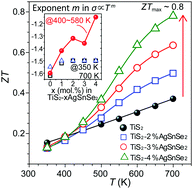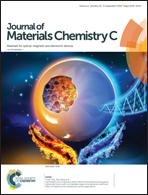Doubling the ZT record of TiS2-based thermoelectrics by incorporation of ionized impurity scattering†
Abstract
1T-type TiS2 has been recognized as a promising environmentally friendly thermoelectric material with a record ZT of around 0.4 so far. We hereby report the high thermoelectric performance of a series of TiS2–xAgSnSe2 composites with nano-AgSnSe2 as an ionized impurity for electron scattering. Electrical conductivities (σ) in the composites increased possibly due to intercalation; moreover, they showed an exceptional power law decay of σ ∝ Tm with m much increased in the temperature range of 400–580 K due to a significant contribution of ionized impurity scattering. Correspondingly, Seebeck coefficients (S) experience a much faster growth from ∼450 K to approach and even surpass that in pristine TiS2. The simultaneous enhancement of σ and S enabled a high power factor of ∼1.55 mW m−1 K−1 at 700 K. Besides, the lattice thermal conductivity was effectively reduced due to enhanced phonon scattering and intercalations, almost by half from 1.9 W m−1 K−1 to 1.0 W m−1 K−1 at 700 K. These synergistic effects renewed the record of ZT for TiS2-based thermoelectrics by almost doubling it to ∼0.8 at 700 K in the TiS2–4%AgSnSe2 composite.



 Please wait while we load your content...
Please wait while we load your content...